Optimizing Ridge–Furrow Ratio to Improve Water Resource Utilization for Wheat in the North China Plain
Abstract
1. Introduction
2. Materials and Patterns
2.1. Site Description
2.2. Experimental Design
2.3. Measurements and Calculations
2.3.1. Soil Water Storage (SWS) and Temperature
2.3.2. Characteristic Root Parameters
2.3.3. Accumulated Dry Matter
2.3.4. Grain Yield and WUE
2.4. Statistical Analyses
3. Results
3.1. Soil Temperature
3.2. Soil Water Storage
3.3. Soil Moisture Distribution after Irrigation at Jointing and Anthesis
3.4. Soil Water Consumption at the 0–100 cm Soil Depth
3.5. Evapotranspiration Source and Its Proportion
3.6. Root Traits
3.7. Grain Yield, Evapotranspiration, and Water Productivity
3.8. Analysis of Relationship
4. Discussion
4.1. Grain Yield and Water Use Efficiency
4.2. Relationship between Root Distribution and Water Use
4.3. Ridge–Furrow Planting Patterns and Soil Environment Lead to Differences in Evapotranspiration Sources
5. Conclusions
Author Contributions
Funding
Data Availability Statement
Conflicts of Interest
References
- Zeng, R.Y.; Yao, F.M.; Zhang, S.; Yang, S.S.; Ba, Y.; Zhang, J.H.; Wang, J.W.; Wang, X. Assessing the effects of precipitation and irrigation on winter wheat yield and water productivity in North China Plain. Agric. Water Manag. 2021, 256, 107063. [Google Scholar] [CrossRef]
- Han, L.; Li, Y.R.; Hou, Y.H.; Liang, H.; Feng, P.Y.; Hu, K.L. Improvement of Water and Nitrogen Use Efficiencies by Alternative Cropping Systems Based on a patternl Approach. Plants 2023, 12, 597. [Google Scholar] [CrossRef]
- Wang, Y.Q.; Zhang, Y.H.; Zhang, R.; Li, J.P.; Zhang, M.; Zhou, S.L.; Wang, Z.M. Reduced irrigation increases the water use efficiency and productivity of winter wheat-summer maize rotation on the North China Plain. Sci. Total Environ. 2018, 618, 112–120. [Google Scholar] [CrossRef]
- Sun, L.; Zhang, Y.B.; Si, H.Y.; Ealotswe, T.K.; Wei, L.; Jin, P.C.; Song, Z.Y.; Lu, C.P. Simulation and prediction of shallow groundwater depth in the North China Plain based on regional periodic characteristics. Environ. Earth Sci. 2021, 80, 635. [Google Scholar] [CrossRef]
- Yang, G.Y.; Li, S.Y.; Wang, H.; Wang, L. Study on agricultural cultivation development layout based on the matching characteristic of water and land resources in North China Plain. Agric. Water Manag. 2022, 259, 107272. [Google Scholar] [CrossRef]
- Dong, F.; Yan, Q.Y.; Yang, F.; Zhang, J.C.; Wang, J.L. Yield structure and water use efficiency of summer maize (Zea mays L.) under wide ridge-furrow planting in the furrow irrigation process. Arch. Agron. Soil Sci. 2023, 69, 228–242. [Google Scholar] [CrossRef]
- Bai, S.S.; Kang, Y.H.; Wan, S.Q. Drip fertigation regimes for winter wheat in the North China Plain. Agric. Water Manag. 2020, 228, 105885. [Google Scholar] [CrossRef]
- Feng, X.Y.; Liu, H.J.; Feng, D.X.; Tang, X.P.; Li, L.; Chang, J.; Tanny, J.; Liu, R.H. Quantifying winter wheat evapotranspiration and crop coefficients under sprinkler irrigation using eddy covariance technology in the North China Plain. Agric. Water Manag. 2023, 277, 108131. [Google Scholar] [CrossRef]
- Zhai, L.C.; Lü, L.H.; Dong, Z.Q.; Zhang, L.H.; Zhang, J.T.; Jia, X.L.; Zhang, Z.B. The water-saving potential of using micro-sprinkling irrigation for winter wheat production on the North China Plain. J. Integr. Agric. 2021, 20, 1687–1700. [Google Scholar] [CrossRef]
- Zhang, D.; Li, D.X.; Wang, H.G.; Li, H.R.; Li, R.Q.; Batchelor, W.D.; Ju, H.; Li, Y.M. Tillage practices offset wheat yield reductions under limited irrigation regime in the North China Plain. Soil Tillage Res. 2023, 230, 105687. [Google Scholar] [CrossRef]
- Zhao, D.D.; Shen, J.Y.; Lang, K.; Liu, Q.R.; Li, Q.Q. Effects of irrigation and wide-precision planting on water use, radiation interception, and grain yield of winter wheat in the North China Plain. Agric. Water Manag. 2013, 118, 87–92. [Google Scholar]
- Xu, Y.Y.; Wang, Y.X.; Ma, X.C.; Liu, X.; Zhang, P.; Cai, T.; Jia, Z.K. Ridge-furrow mulching system and supplementary irrigation can reduce the greenhouse gas emission intensity. Sci. Total Environ. 2020, 717, 137262. [Google Scholar] [CrossRef] [PubMed]
- Zhang, G.X.; Dai, R.C.; Ma, W.Z.; Fan, H.Z.; Meng, W.H.; Han, J.; Liao, Y.C. Optimizing the ridge-furrow ratio and nitrogen application rate can increase the grain yield and water use efficiency of rain-fed spring maize in the Loess Plateau region of China. Agric. Water Manag. 2022, 262, 107430. [Google Scholar] [CrossRef]
- Liu, P.; Wang, H.L.; Li, L.C.; Liu, X.L.; Qian, R.; Wang, J.J.; Yan, X.Q.; Cai, T.; Zhang, P.; Jia, Z.K.; et al. Ridge-furrow mulching system regulates hydrothermal conditions to promote maize yield and efficient water use in rainfed farming area. Agric. Water Manag. 2020, 232, 106041. [Google Scholar] [CrossRef]
- Ren, X.L.; Cai, T.; Chen, X.L.; Zhang, P.; Jia, Z.K. Effect of rainfall concentration with different ridge widths on winter wheat production under semiarid climate. Eur. J. Agron. 2016, 77, 20–27. [Google Scholar] [CrossRef]
- Li, R.F.; Ma, J.J.; Sun, X.H.; Guo, X.H.; Zheng, L.J. Simulation of soil water and heat flow under plastic mulching and different ridge patterns. Agriculture 2021, 11, 1099. [Google Scholar] [CrossRef]
- Liu, X.L.; Wang, Y.D.; Yan, X.Q.; Hou, H.Z.; Liu, P.; Cai, T.; Zhang, P.; Jia, Z.K.; Ren, X.L.; Chen, X.L. Appropriate ridge-furrow ratio can enhance crop production and resource use efficiency by improving soil moisture and thermal condition in a semi-arid region. Agric. Water Manag. 2020, 240, 106289. [Google Scholar] [CrossRef]
- Luo, C.L.; Zhang, X.F.; Duan, H.X.; Zhou, R.; Mo, F.; Mburu, D.M.; Wang, B.Z.; Wang, W.; Kavagi, L.; Xiong, Y.C. Responses of rainfed wheat productivity to varying ridge-furrow size and ratio in semiarid eastern African Plateau. Agric. Water Manag. 2021, 249, 106813. [Google Scholar] [CrossRef]
- Hu, Y.J.; Ma, P.H.; Wu, S.F.; Sun, B.H.; Feng, H.; Pan, X.L.; Zhang, B.B.; Chen, G.J.; Duan, C.X.; Lei, Q.; et al. Spatial-temporal distribution of winter wheat (Triticum aestivum L.) roots and water use efficiency under ridge-furrow dual mulching. Agric. Water Manag. 2020, 240, 106301. [Google Scholar] [CrossRef]
- Chen, X.Y.; Zhu, Y.; Ding, Y.; Pan, R.M.; Shen, W.Y.; Yu, X.R.; Xiong, F. The relationship between characteristics of root morphology and grain filling in wheat under drought stress. PeerJ 2021, 9, e12015. [Google Scholar] [CrossRef]
- Liu, D.; Mou, S.W.; Zou, Y.F.; Yang, B.P.; Ding, R.X.; Nie, J.F.; Zhang, X.D.; Jia, Z.K.; Han, Q.F. Exploring the relationship between deep roots and shoot growth of wheat under different soil moisture: A large soil column experiment. Rhizosphere 2023, 25, 100675. [Google Scholar] [CrossRef]
- Ali, S.; Xu, Y.Y.; Ahmad, I.; Jia, Q.M.; Ma, X.C.; Ullah, H.; Alam, M.; Adnan, M.; Daur, I.; Ren, X.L.; et al. Tillage and deficit irrigation strategies to improve winter wheat production through regulating root development under simulated rainfall conditions. Agric. Water Manag. 2018, 209, 44–54. [Google Scholar] [CrossRef]
- Du, X.B.; Wei, Z.; Kong, L.C.; Zhang, L.G. Optimal bed width for wheat following rice production with raised-bed planting in the Yangtze River Plain of China. Agric. Water Manag. 2022, 269, 107676. [Google Scholar] [CrossRef]
- You, Y.L.; Song, P.; Yang, X.L.; Zheng, Y.P.; Dong, L.; Chen, J. Optimizing irrigation for winter wheat to maximize yield and maintain high-efficient water use in a semi-arid environment. Agric. Water Manag. 2022, 273, 107901. [Google Scholar] [CrossRef]
- Fang, Y.J.; Tan, W.J.; Hou, H.Z.; Wang, H.L.; Yin, J.D.; Zhang, G.P.; Lei, K.N.; Dong, B.; Qin, A.Z. Effects of Deep Vertical Rotary Tillage on Soil Water Use and Yield Formation of Forage Maize on Semiarid Land. Agriculture 2024, 14, 955. [Google Scholar] [CrossRef]
- Zheng, X.J.; Yu, Z.W.; Shi, Y.; Liang, P. Differences in Water Consumption of Wheat Varieties Are Affected by Root Morphology Characteristics and Post-anthesis Root Senescence. Front. Plant Sci. 2022, 12, 814658. [Google Scholar] [CrossRef]
- Si, Z.Y.; Liu, J.M.; Wu, L.F.; Li, S.; Wang, G.S.; Yu, J.C.; Gao, Y.; Duan, A.W. A high-yield and high-efficiency cultivation pattern of winter wheat in North China Plain: High-low seedbed cultivation. Field Crops Res. 2023, 300, 109010. [Google Scholar] [CrossRef]
- Sun, W.; Shi, H.B.; Li, X.Y.; Miao, Q.F.; Yan, J.W.; Feng, Z.Z.; Qi, Y.L.; Feng, W.Y. Effect of Water Conservation and Nitrogen Reduction on Root Growth and Yield in Spring Maize in Typical Sand Interdepthed Soil. Agriculture 2024, 14, 338. [Google Scholar] [CrossRef]
- Nader, M.O. An improved weighted average simulation approach for solving reliability-based analysis and design optimization problems. Struct. Saf. 2016, 60, 47–55. [Google Scholar]
- Li, T.G.; Gao, F. Nitrogen fertilizer and wheat: Achieving agricultural production and sustainable development. Geogr. Res. Bull. 2024, 3, 28–38. [Google Scholar]
- Liu, L.H.; Lian, Z.M.; Ouyang, W.; Yan, L.L.; Liu, H.B.; Hao, F.H. Potential of optimizing irrigation and fertilization management for sustainable rice production in China. J. Clean. Prod. 2023, 432, 139738. [Google Scholar] [CrossRef]
- Li, H.R.; Li, X.L.; Mei, X.R.; Nangia, V.; Guo, R.; Hao, W.P.; Wang, J.D. An alternative water-fertilizer-saving management practice for wheat-maize cropping system in the North China Plain: Based on a 4-year field study. Agric. Water Manag. 2023, 276, 108053. [Google Scholar] [CrossRef]
- Tang, X.P.; Liu, H.J.; Zhang, Z.L.; Zheng, C.X.; She, Y.J.; Lu, W. Adaptation of sprinkler irrigation scheduling and winter wheat variety to cope with climate change in the North China Plain. Agric. Water Manag. 2024, 301, 108929. [Google Scholar] [CrossRef]
- Li, W.W.; Wen, X.X.; Han, J.; Liu, Y.; Wu, W.; Liao, Y.C. Optimum ridge-to-furrow ratio in ridge-furrow mulching systems for improving water conservation in maize (Zea may L.) production. Environ. Sci. Pollut. R. 2017, 24, 23168–23179. [Google Scholar] [CrossRef]
- Li, W.W.; Xiong, L.; Wang, C.J.; Liao, Y.C.; Wu, W. Optimized ridge-furrow with plastic film mulching system to use precipitation efficiently for winter wheat production in dry semi-humid areas. Agric. Water Manag. 2019, 218, 211–221. [Google Scholar] [CrossRef]
- El-Hendawy, S.; Alsamin, B.; Mohammed, N.; Al-Suhaibani, N.; Refay, Y.; Alotaibi, M.; Tola, E.; Mattar, M.A. Combining planting patterns with mulching bolsters the soil water content, growth, yield, and water use efficiency of spring wheat under limited water supply in arid regions. Agronomy 2022, 12, 1298. [Google Scholar] [CrossRef]
- Qiang, S.C.; Zhang, Y.; Fan, J.L.; Zhang, F.C.; Sun, M.; Gao, Z.Q. Combined effects of ridge–furrow ratio and urea type on grain yield and water productivity of rainfed winter wheat on the Loess Plateau of China. Agric. Water Manag. 2022, 261, 107340. [Google Scholar] [CrossRef]
- Pramanik, P.; Chakrabarti, B.; Bhatia, A.; Singh, S.D.; Maity, A.; Aggarwal, P.; Krishnan, P. Effect of elevated temperature on soil hydrothermal regimes and growth of wheat crop. Environ. Monit. Assess. 2018, 190, 217. [Google Scholar] [CrossRef]
- Sun, Q.; Sun, W.; Zhao, Z.X.; Jiang, W.; Zhang, P.Y.; Sun, X.F.; Xue, Q.W. Soil Compaction and Maize Root Distribution under Subsoiling Tillage in a Wheat–Maize Double Cropping System. Agronomy 2023, 13, 394. [Google Scholar] [CrossRef]
- Zhang, G.X.; Hou, Y.T.; Zhang, H.P.; Fan, H.Z.; Wen, X.X.; Han, J.; Liao, Y.C. Optimizing planting pattern and nitrogen application rate improves grain yield and water use efficiency for rain-fed spring maize by promoting root growth and reducing redundant root growth. Soil Tillage Res. 2022, 220, 107340. [Google Scholar] [CrossRef]
- Zhang, J.J.; Mu, J.Y.; Hu, Y.N.; Ren, A.X.; Lei, B.; Ding, P.C.; Li, L.H.; Sun, M.; Gao, Z.Q. Effect of planting patterns and seeding rate on dryland wheat yield formation and water use efficiency on the Loess Plateau, China. Agronomy 2023, 13, 851. [Google Scholar] [CrossRef]
- Liu, Y.; Zhang, X.L.; Xi, L.Y.; Liao, Y.C.; Han, J. Ridge-furrow planting promotes wheat grain yield and water productivity in the irrigated sub-humid region of China. Agric. Water Manag. 2020, 231, 105935. [Google Scholar] [CrossRef]
- Ning, D.F.; Chen, H.Q.; Qin, A.Z.; Gao, Y.; Zhang, J.Y.; Duan, A.W.; Wang, X.P.; Liu, Z.D. Optimizing irrigation and N fertigation regimes achieved high yield and water productivity and low N leaching in a maize field in the North China Plain. Agric. Water Manag. 2024, 301, 108945. [Google Scholar] [CrossRef]
- Fan, Y.F.; He, L.Y.; Liu, Y.; Wang, S.F. Optimal cropping patterns can be conducive to sustainable irrigation: Evidence from the drylands of Northwest China. Agric. Water Manag. 2022, 274, 107977. [Google Scholar] [CrossRef]
- Wu, J.Z.; Guan, H.Y.; Wang, Z.M.; Li, Y.J.; Fu, G.Z.; Huang, M.; Li, G.Q. Alternative furrow irrigation combined with topdressing nitrogen at jointing help yield formation and water use of winter wheat under no-till ridge furrow planting system in semi-humid drought-prone areas of China. Agronomy 2023, 13, 1390. [Google Scholar] [CrossRef]
- Yin, W.; Chai, Q.; Guo, Y.; Fan, Z.L.; Hu, F.L.; Fan, H.; Zhao, C.; Yu, A.Z.; Coulter, J.A. Straw and plastic management regulate air-soil temperature amplitude and wetting-drying alternation in soil to promote intercrop productivity in arid regions. Field Crops Res. 2020, 249, 107758. [Google Scholar] [CrossRef]
- Fan, Y.; Wang, X.X.; Chen, R.Q.; Dang, H.K.; Liu, H.Q. Differences in Water Consumption and Yield Characteristics among Winter Wheat (Triticum aestivum L.) Varieties under Different Irrigation Systems. Appl. Sci. 2023, 13, 4396. [Google Scholar] [CrossRef]
- Khan, S.; Anwar, S.; Sun, M.; Shafiq, F.; Khalilzadeh, R.; Gao, Z.Q. Characterizing Differences in Soil Water Content and Wheat Yield in Response to Tillage and Precipitation in the Dry, Normal, and Wet Years at the Loess Plateau. Int. J. Plant Prod. 2021, 15, 655–668. [Google Scholar] [CrossRef]
- Yin, W.; Fan, Z.L.; Hu, F.L.; Fan, H.; He, W.; Zhao, C.; Yu, A.Z.; Chai, Q. No-tillage with straw mulching promotes wheat production via regulating soil drying-wetting status and reducing soil-air temperature variation at arid regions. Eur. J. Agron. 2023, 145, 126778. [Google Scholar] [CrossRef]
- Zhang, X.M.; Wang, R.; Liu, B.; Wang, Y.C.; Yang, L.C.; Zhao, J.; Xu, J.; Li, Z.M.; Zhang, X.D.; Han, Q.F. Optimization of ridge-furrow mulching ratio enhances precipitation collection before silking to improve maize yield in a semi-arid region. Agric. Water Manag. 2023, 275, 108041. [Google Scholar] [CrossRef]
- Oyeyemi, K.D.; Sanuade, O.A.; Oladunjoye, M.A.; Aizebeokhai, A.P.; Olaojo, A.A.; Fatoba, J.O.; Olofinnade, O.M.; Ayara, W.A.; Oladapo, O. Data on the thermal properties of soil and its moisture content. Data Brief 2018, 17, 900–906. [Google Scholar] [CrossRef] [PubMed]
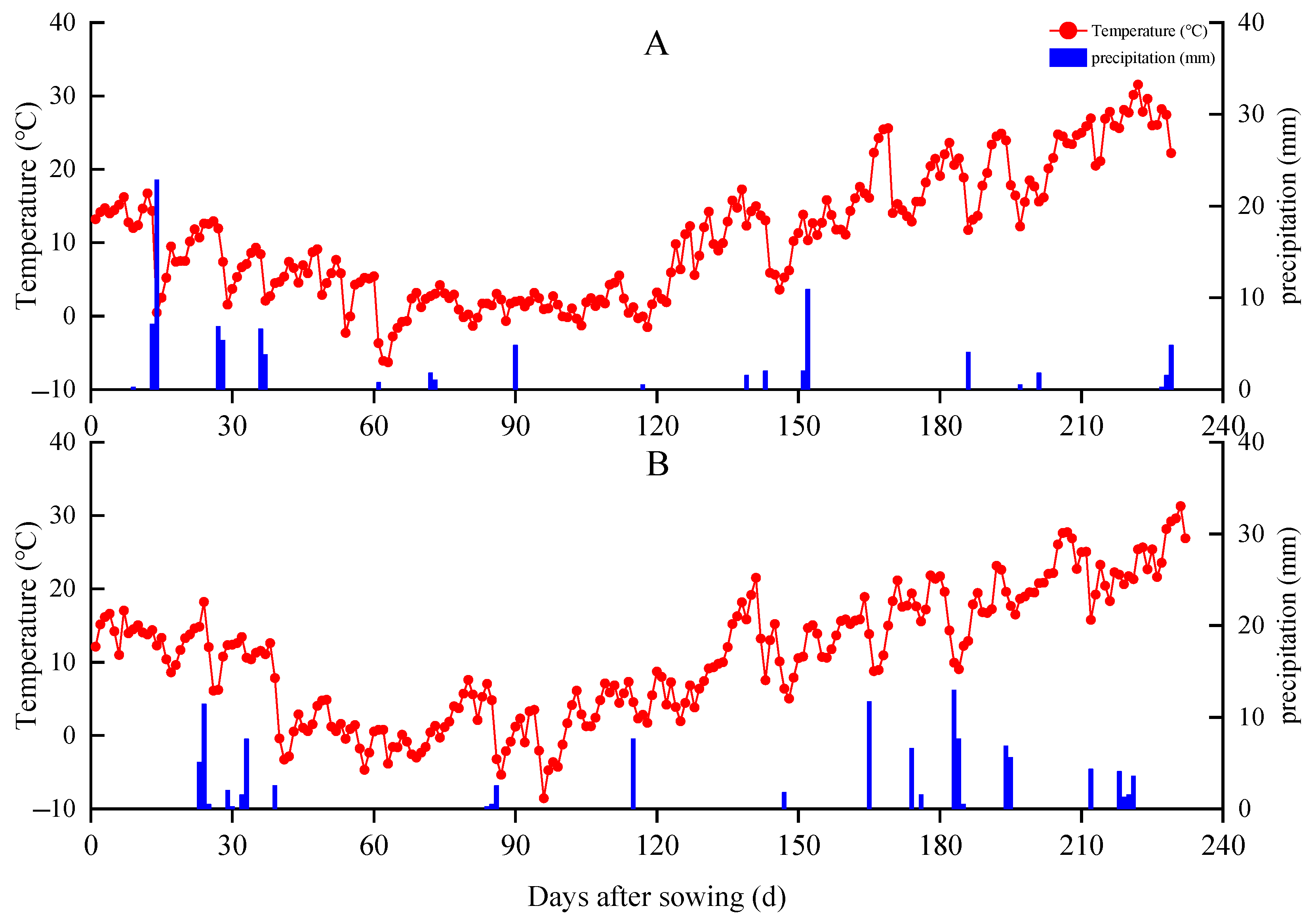
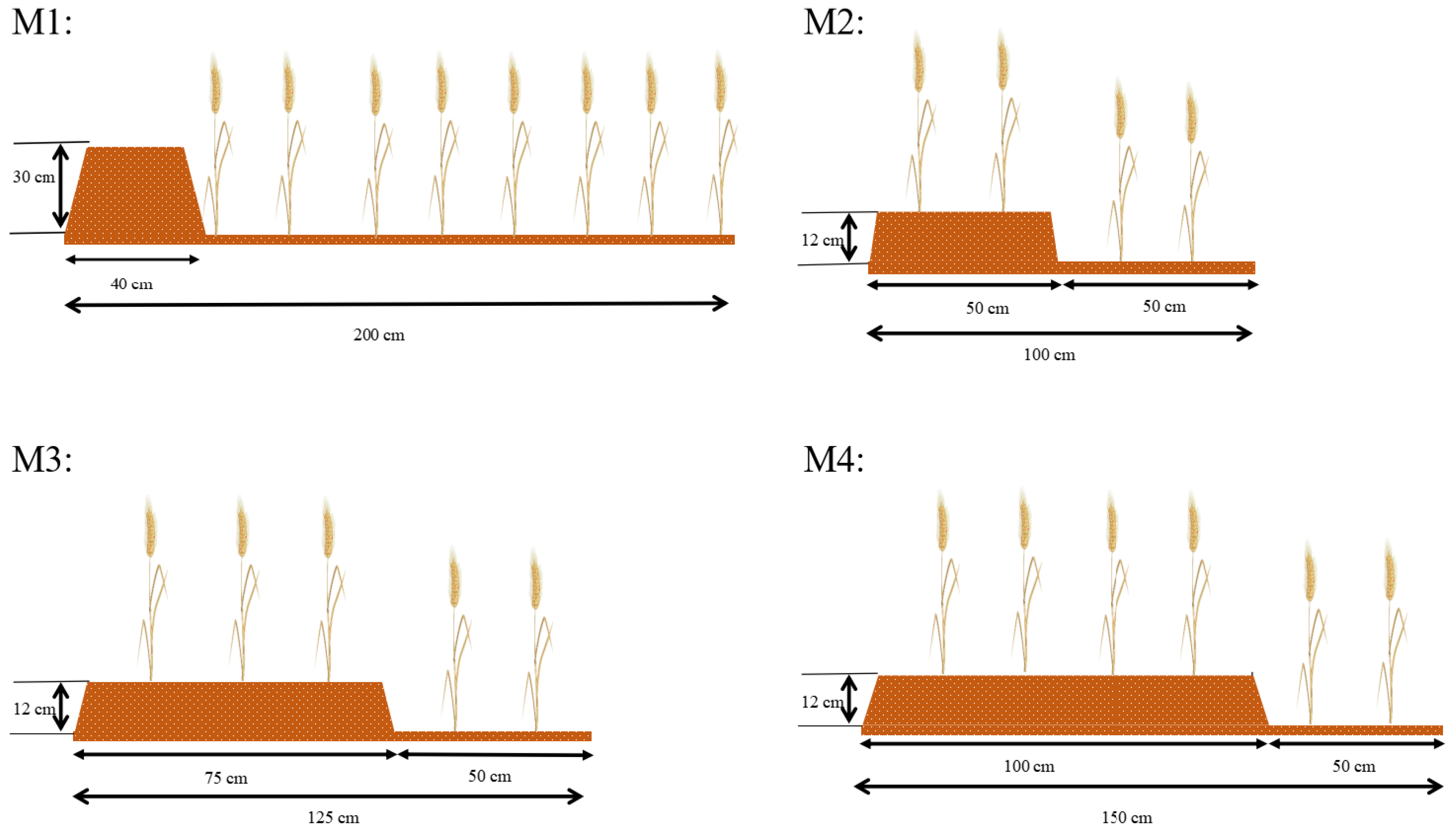

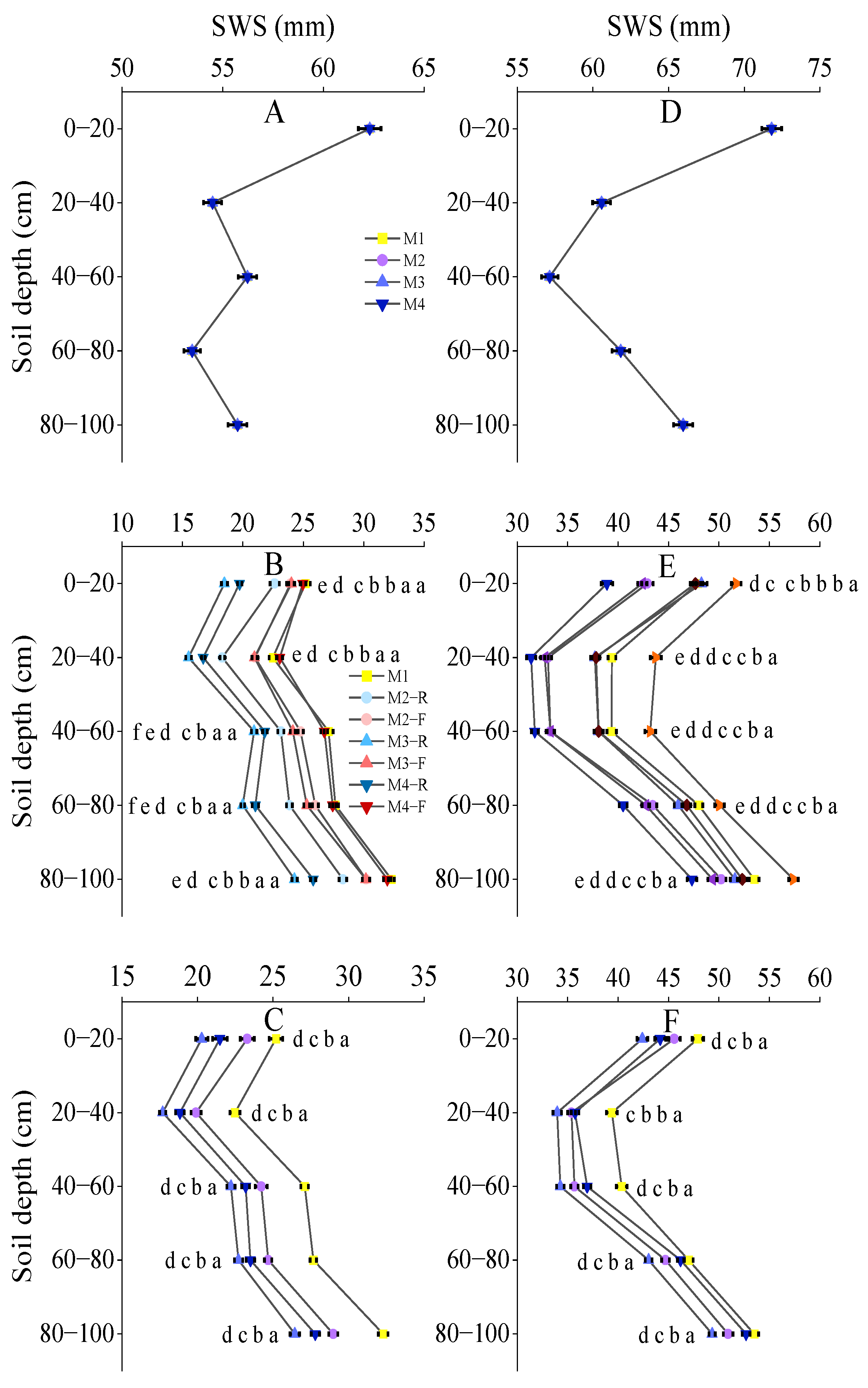
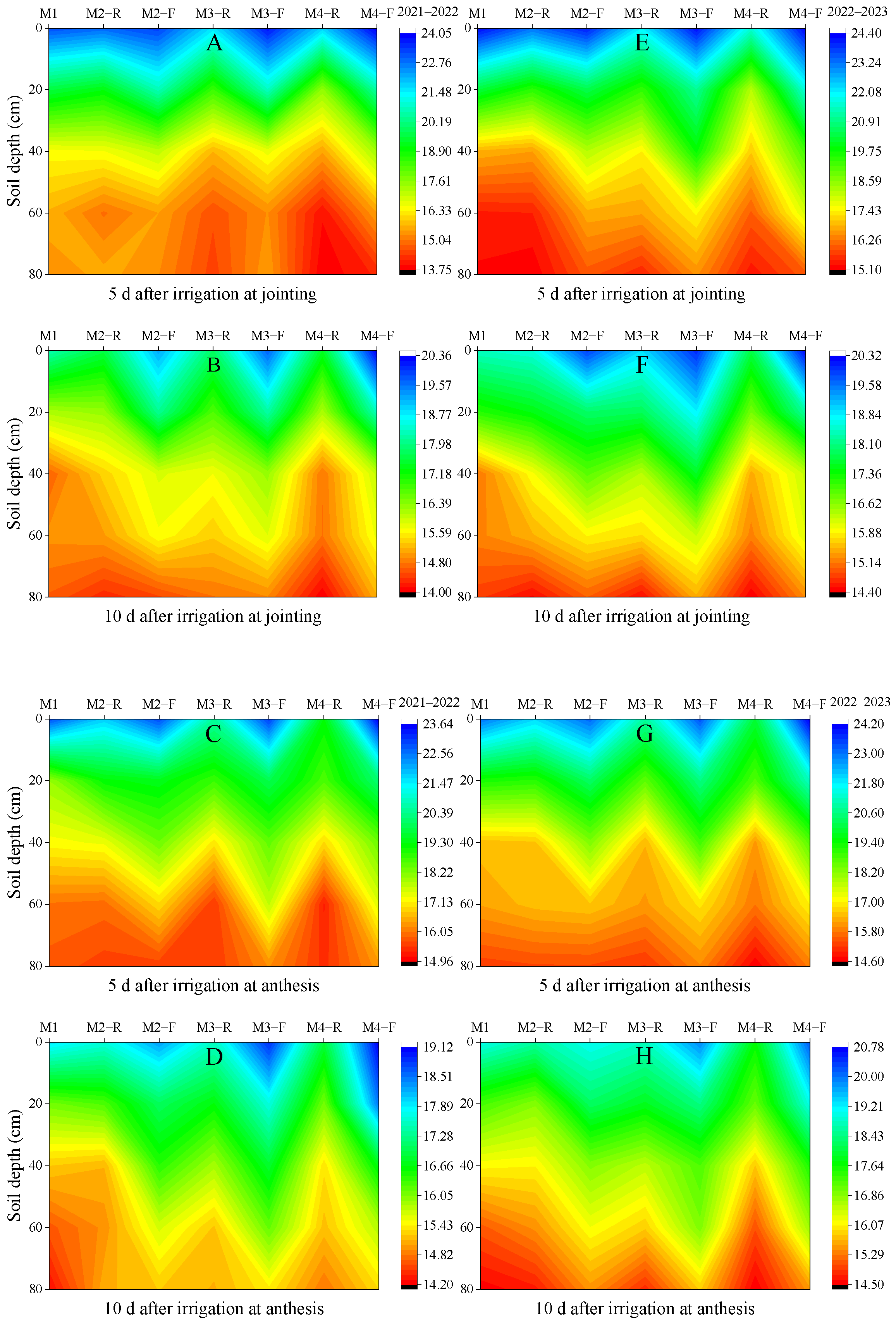

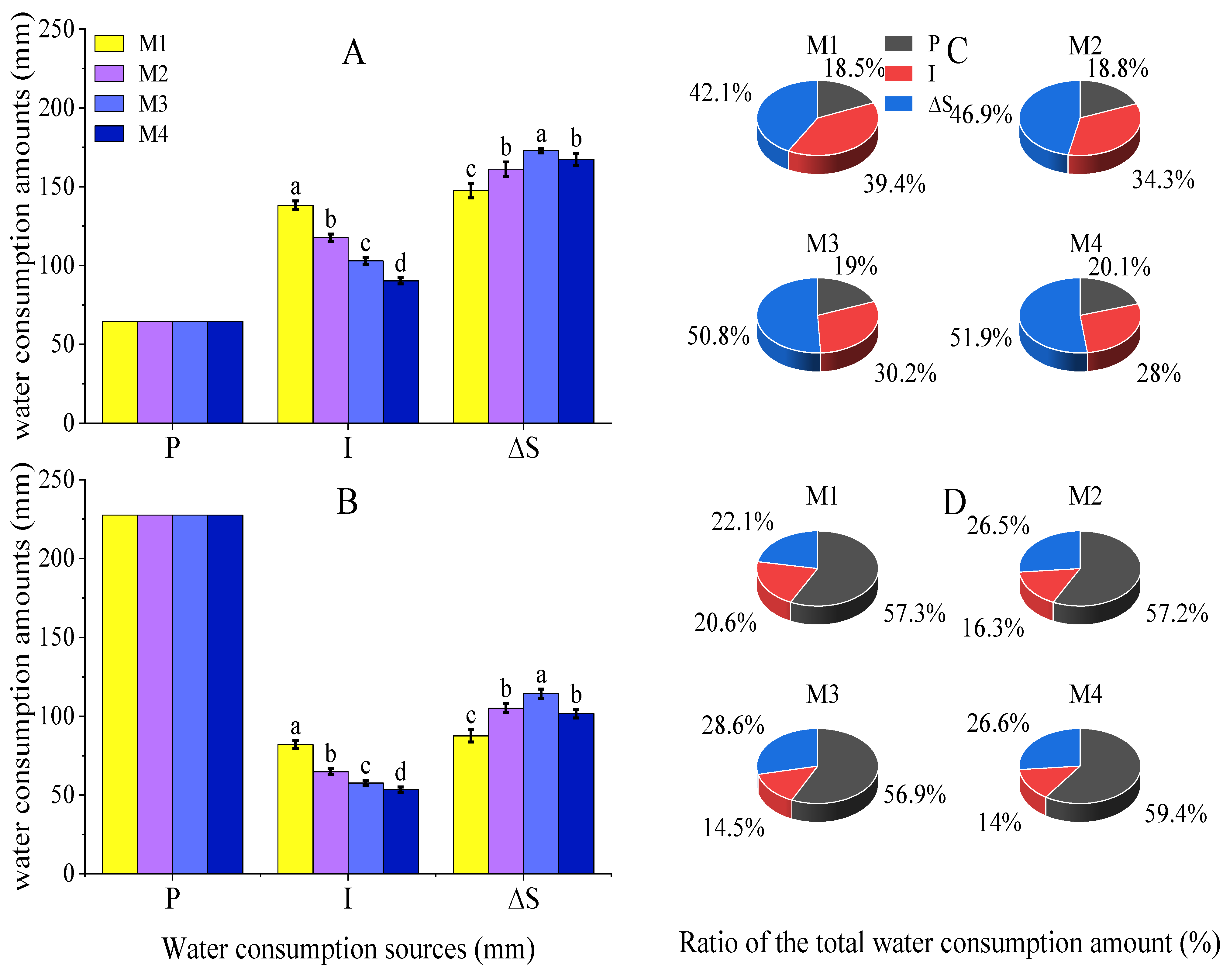


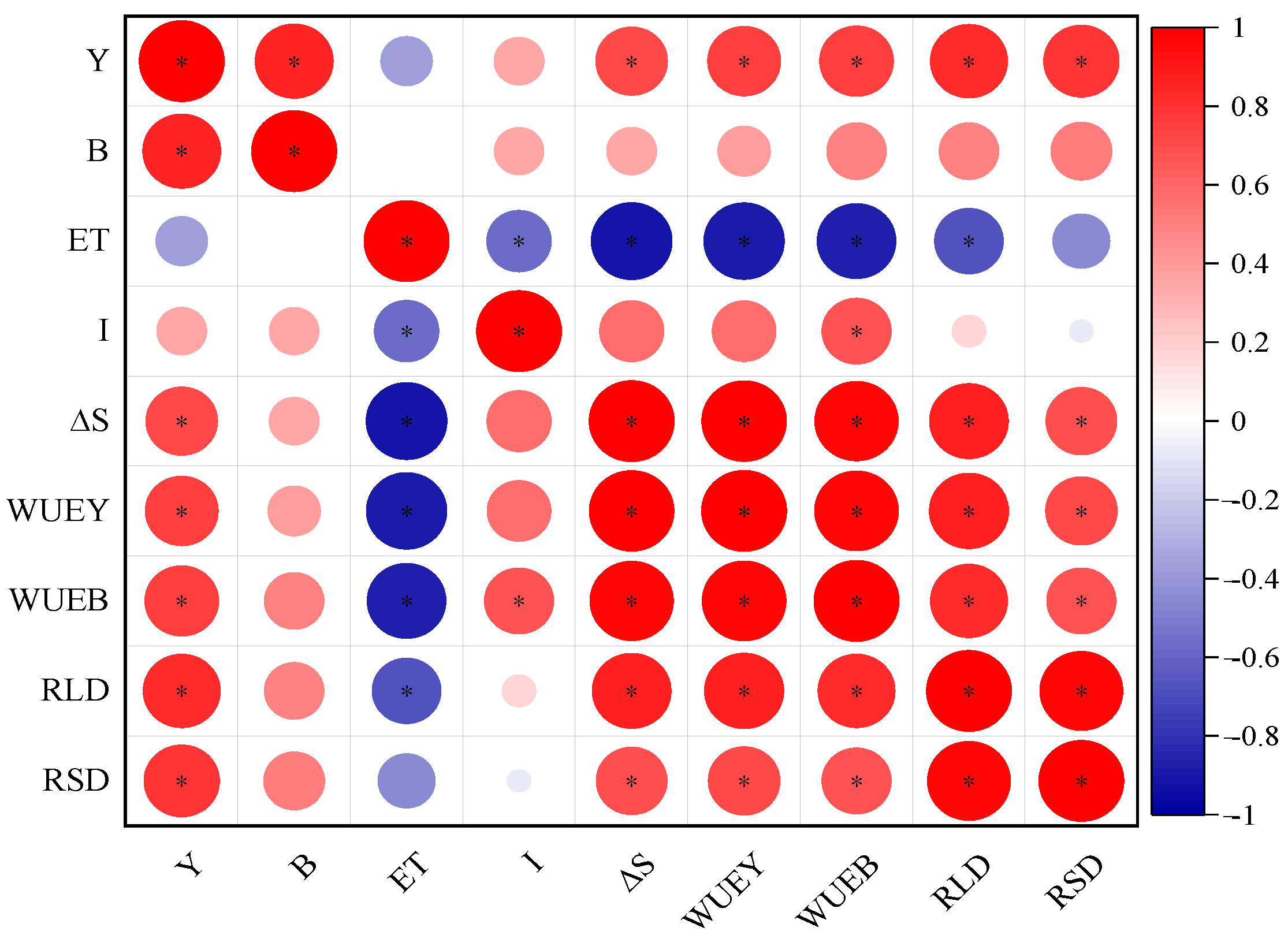
| Year | Organic Matter | Total Nitrogen | Available Nitrogen | Available Phosphorus | Available Potassium | Bulk Density |
|---|---|---|---|---|---|---|
| g·kg−1 | g·kg−1 | mg·kg−1 | mg·kg−1 | mg·kg−1 | g·cm−3 | |
| 2021–2022 | 14.79 | 1.23 | 120.30 | 30.86 | 119.60 | 1.50 |
| 2022–2023 | 14.97 | 1.15 | 115.17 | 32.20 | 127.13 | 1.51 |
| Year | Treatment | Jointing | Anthesis | Total |
|---|---|---|---|---|
| (mm) | (mm) | (mm) | ||
| 2021–2022 | M1 | 75.40 | 62.83 | 138.23 |
| M2 | 64.60 | 53.10 | 117.70 | |
| M3 | 57.60 | 45.34 | 102.94 | |
| M4 | 50.51 | 39.78 | 90.29 | |
| 2022–2023 | M1 | 44.23 | 37.78 | 82.02 |
| M2 | 32.23 | 32.67 | 64.90 | |
| M3 | 28.68 | 29.07 | 57.75 | |
| M4 | 26.57 | 27.00 | 53.57 |
| Year | Treatment | Y (kg·hm−2) | B (kg·hm−2) | ET (mm) | WUEY (kg·ha−1·mm−1) | WUEB (kg·ha−1·mm−1) |
|---|---|---|---|---|---|---|
| 2021–2022 | M1 | 9101.2 c | 19,515 b | 350.5 a | 25.97 c | 55.69 b |
| M2 | 9505.0 b | 19,573 b | 343.6 a | 27.67 b | 56.97 b | |
| M3 | 9802.5 a | 20,452 a | 340.5 a | 28.79 a | 60.06 a | |
| M4 | 9018.9 c | 18,209 c | 322.4 b | 27.97 b | 56.47 b | |
| 2022–2023 | M1 | 8538.3 c | 18,921 b | 397.1 a | 21.50 c | 47.65 b |
| M2 | 8926.7 b | 18,797 b | 397.5 a | 22.46 b | 47.29 b | |
| M3 | 9354.9 a | 19,954 a | 399.6 a | 23.41 a | 49.93 a | |
| M4 | 8435.2 c | 18,214 c | 382.7 b | 22.04 b | 47.59 b |
Disclaimer/Publisher’s Note: The statements, opinions and data contained in all publications are solely those of the individual author(s) and contributor(s) and not of MDPI and/or the editor(s). MDPI and/or the editor(s) disclaim responsibility for any injury to people or property resulting from any ideas, methods, instructions or products referred to in the content. |
© 2024 by the authors. Licensee MDPI, Basel, Switzerland. This article is an open access article distributed under the terms and conditions of the Creative Commons Attribution (CC BY) license (https://creativecommons.org/licenses/by/4.0/).
Share and Cite
Liu, K.; Zhang, Z.; Shi, Y.; Wang, X.; Yu, Z. Optimizing Ridge–Furrow Ratio to Improve Water Resource Utilization for Wheat in the North China Plain. Agriculture 2024, 14, 1579. https://doi.org/10.3390/agriculture14091579
Liu K, Zhang Z, Shi Y, Wang X, Yu Z. Optimizing Ridge–Furrow Ratio to Improve Water Resource Utilization for Wheat in the North China Plain. Agriculture. 2024; 14(9):1579. https://doi.org/10.3390/agriculture14091579
Chicago/Turabian StyleLiu, Kun, Zhen Zhang, Yu Shi, Xizhi Wang, and Zhenwen Yu. 2024. "Optimizing Ridge–Furrow Ratio to Improve Water Resource Utilization for Wheat in the North China Plain" Agriculture 14, no. 9: 1579. https://doi.org/10.3390/agriculture14091579
APA StyleLiu, K., Zhang, Z., Shi, Y., Wang, X., & Yu, Z. (2024). Optimizing Ridge–Furrow Ratio to Improve Water Resource Utilization for Wheat in the North China Plain. Agriculture, 14(9), 1579. https://doi.org/10.3390/agriculture14091579






